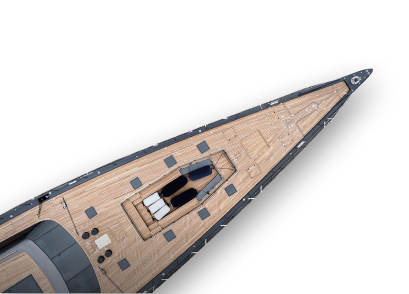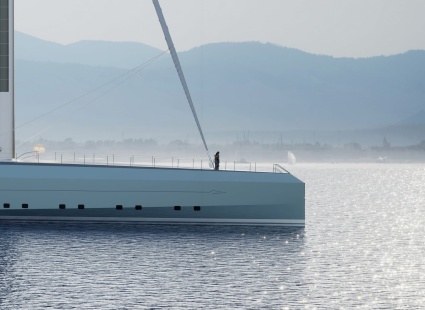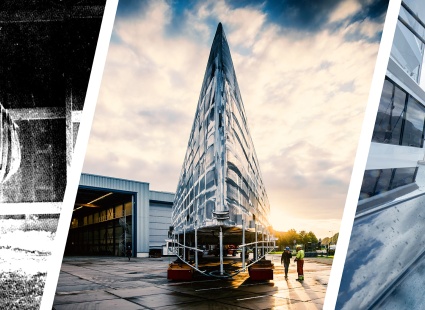READY ABOUT!
It is a blustery, early summer evening in the English Channel in the 1970s. A large fleet of racing yachts is beating to windward on the first leg of a long off shore race. Bows lift and plunge against the short, steep seas and spray is flung back at the crew sitting out the windward rail. Helmsmen and tacticians keep a wary eye on their main rivals. Someone is sure to make a move soon. The tension is high: Admiral’s Cup team places rest on the outcome.
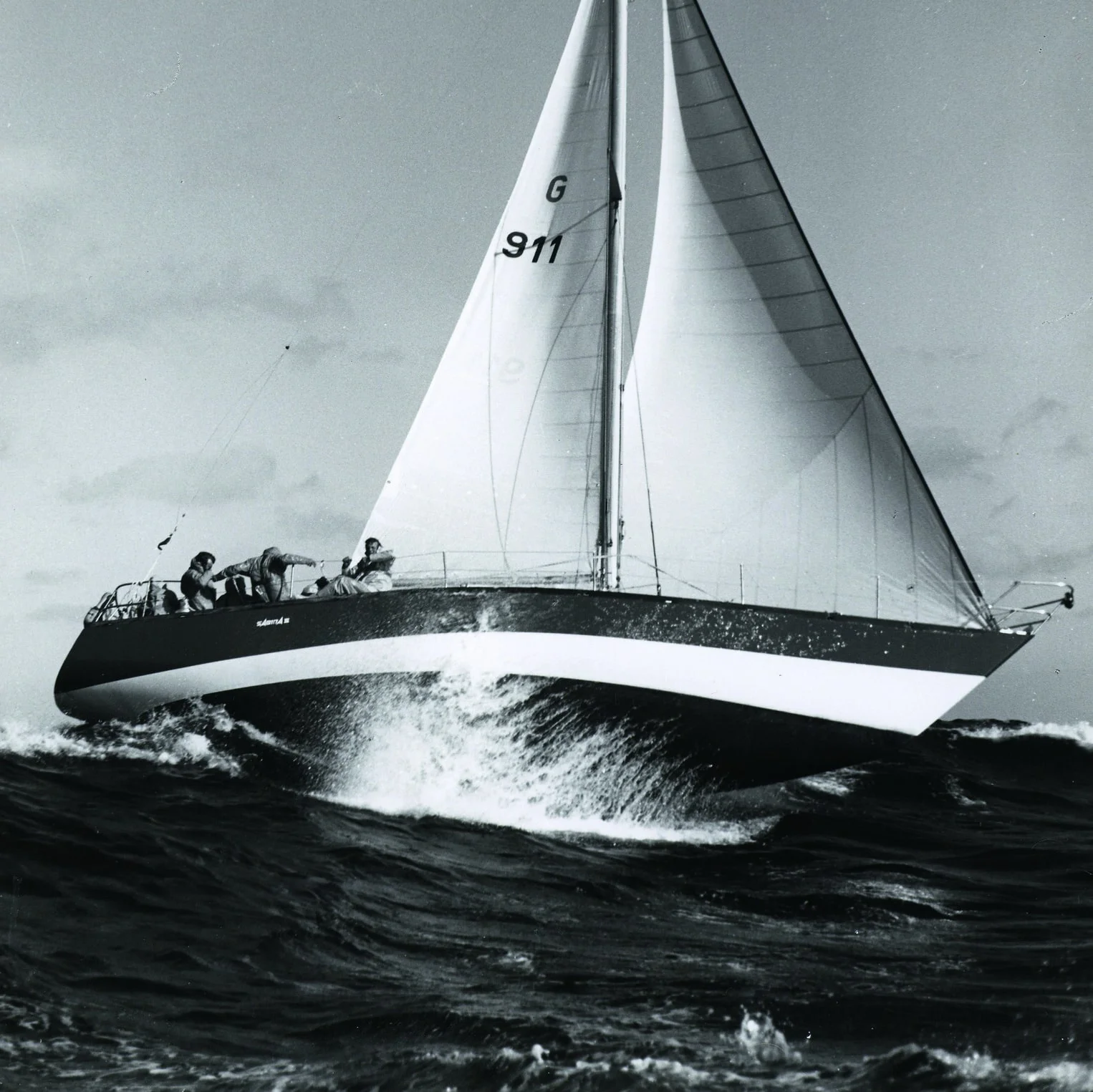
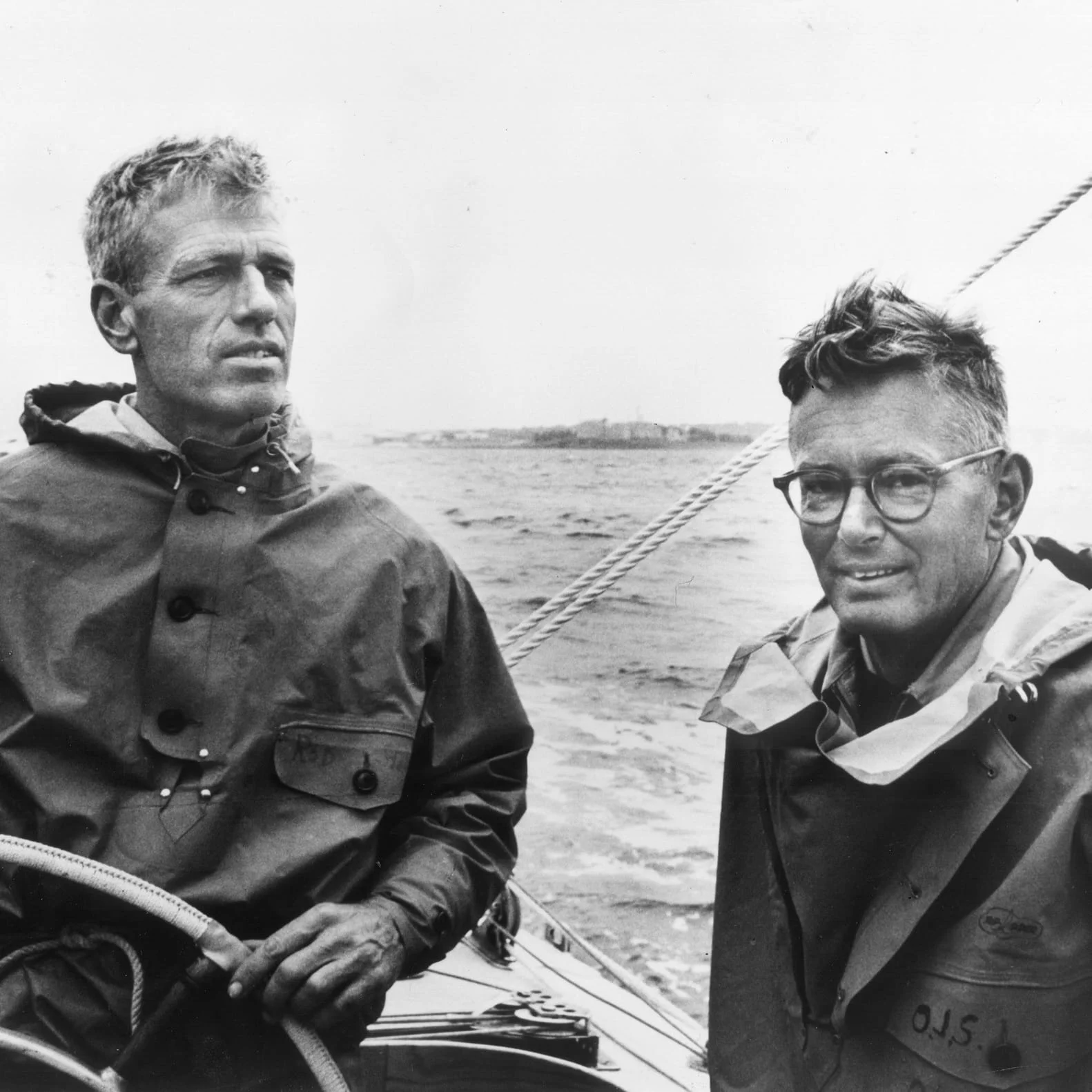
They’ve gone! A Sparkman & Stephens-designed lightweight aluminium yacht, recently launched from the Huisman yard in Holland, makes a smart tack onto starboard. Her German skipper has made a good call.
Ready about! The crew of a British yacht leap from the rail and take their stations. They, too, are sailing a custom, Huisman-built race yacht designed by Sparkman & Stephens. Two determined skippers and crews on two cutting-edge yachts from a leading designer and an up-and-coming builder of the day begin to battle it out…
From the late 1960s until the early 1980s the Huisman yard was close to the epicentre of an increasingly active and competitive ocean racing scene, building more than 100 custom race boats from Admiral’s Cuppers, through an OSTAR (Single-Handed Trans-Atlantic Race) entry and Ton classes, to full-blown Maxis.
The post-war austerity of the 1950s had gradually been replaced by the more positive mood and economic resurgence of the sixties. Increasing affluence and a focus on leisure activities provided the basis for strong growth in yacht ownership and a major revival for yacht racing, which developed apace into the seventies and eighties.
The names of the yachts built at Huisman – Pinta, Saudade, Sabina, Prospect of Whitby, Noryema, Gitana, Revolution, Winsome, Spirit of Delft, Helisara and Flyer to name a few – were as famous in their time as Wild Oats, Alinghi, Comanche (and, yes, Pinta) in the modern era. This was the last, exuberant age of the larger than life, non-professional owner- skipper, who sailed with Corinthian pride for the sheer excitement, the silver pot and, equally importantly, the last laugh over his deadliest rivals. You didn’t earn any money ocean-racing in those days but you could certainly spend it. Those who did were often self-made businessmen but there remained a signifi cant group of “gentleman sailors” whose family fortunes had somehow survived the war era and, whatever the difference in backgrounds, were capable of being just as aggressive on the water as the entrepreneurs.
As with the boats, the names of the owners who built at Huisman had an exceptionally high profile within the sailing community and beyond – Albert Büll, Arthur Slater, Willi Illbruck, Ron Amey, Hermann Noack, Jean-Louis Fabry, Conny van Rietschoten and Herbert von Karajan all commissioned one or more yachts (in the case of one owner, five) from the yard.
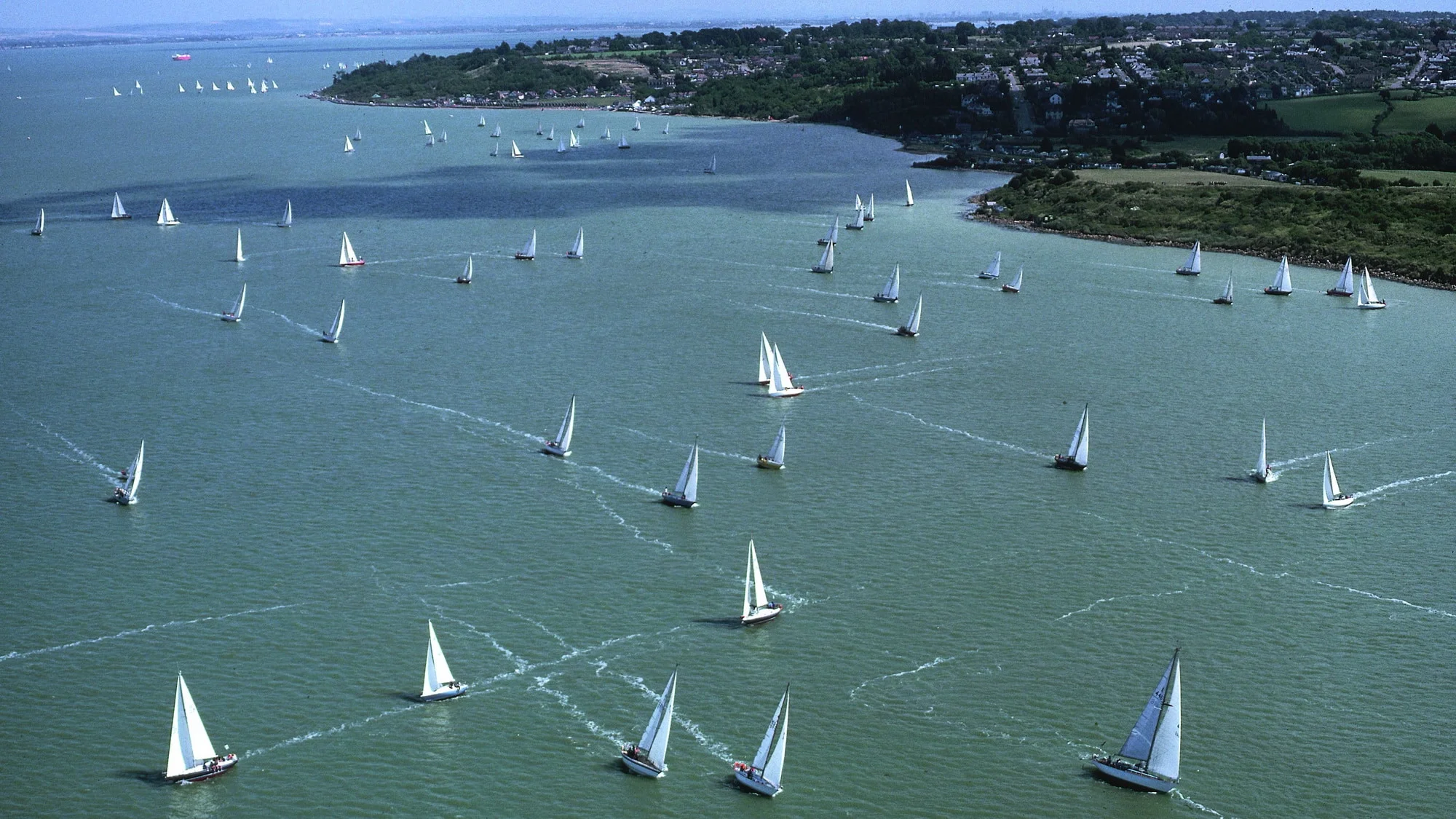
The Sparkman & Stephens factor
The reasons that so many high-profile owners brought their latest, rule-challenging designs to a modest yard in the Netherlands are numerous. But three stand out: aluminium, Sparkman & Stephens and Wolter Huisman. Although the Huisman yard had been building aluminium yachts since the mid 1960s, the adoption of the material in the construction of racing yachts was relatively slow. In general, 1960s racing yachts were built from wood, steel or the rapidly advancing new material, fibreglass (GRP). Aluminium offered excellent weight and build advantages over virtually all other materials at that time, yet, perhaps for cost reasons, few yards had explored the technology and made the transition, with the notable exception of Palmer Johnson in the United States.
In the late 1960s, Huisman received an important order as an unexpected but very welcome result of a visit by Rod Stephens to the Huisman stand at the Dutch HISWA Boat Show three years earlier. It would be the yard’s largest yacht to date, its first Sparkman & Stephens design, and the first yacht to be built at the newly acquired Vollenhove site. At this time, all Huisman yachts were built at Ronduite, but there were no sheds there large enough to build, nor water deep enough to launch, an 18.4 m / 60 ft racing yacht. Ever practical, Wolter Huisman simply had his men move to Vollenhove all the machinery required to construct the now legendary Running Tide; he then shipped it back to Ronduite when the yacht was completed.
The larger the yacht, the greater the weight advantages of building in aluminium, so designer Rod Stephens took a particular interest in the Running Tide project, especially because it was the first construction of a Sparkman & Stephens design by this little-known European yard.
Situated as it was in a seemingly remote region of the Netherlands, the Huisman yard must have seemed very far removed, culturally and geographically, from the sophistication of Sparkman & Stephens’ Manhattan offices on Madison Avenue. Rod Stephens need not have worried: although he appreciated that Running Tide represented a new level of challenge for Huisman, he was exceptionally impressed by the standards of craftsmanship that he saw in the boat when she was delivered to the United States. Rod’s (and brother Olin’s) seal of approval was of enormous importance to Wolter Huisman and his team.
At this time – and for many years to come – Sparkman & Stephens was emphatically the dominant racing yacht design force on the international stage. Huisman alone ended up building twenty-nine Sparkman & Stephens designs in the years ahead, and a glance at the entry lists for the Admiral’s Cup, Sardinia Cup, SORC, Southern Cross or Onion Patch series during that period would reveal an extraordinarily high concentration of Sparkman & Stephens-designed entries.
As an increasing number of owners commissioned Sparkman & Stephens to design yet faster, even more advantageously handicapped, all-points-of-sailing performers for the coming season, so more customers were referred to the Huisman yard as a build option worth considering. Owners would benefit not only from a strong, relatively lightweight yacht but also from an extraordinarily inventive, can-do culture led by the yard’s passionately energetic and enthusiastic owner. The orders rapidly stacked up, to the extent that the yard was regularly building up to seven racing yachts a year, completing a hull within three months and a finished boat within nine.
(The intense pressure for increasingly short build times – so that owners and designers could build and race with the benefit of the best possible handicap based on the latest rule changes – was one of the major reasons why Wolter Huisman ultimately took the decision to move from building racing yachts to luxury cruising yachts.)
The large order book for Sparkman & Stephens designs meant that Rod Stephens became a regular visitor to the Huisman yard, and it is worth noting here the generosity of spirit for which he was remembered in giving his time and advice, not only to Wolter Huisman but also to younger members of the Huisman entourage, including in-house designer Jurrie Zandbergen and naval architects Jac de Ridder and Gerard Dijkstra.
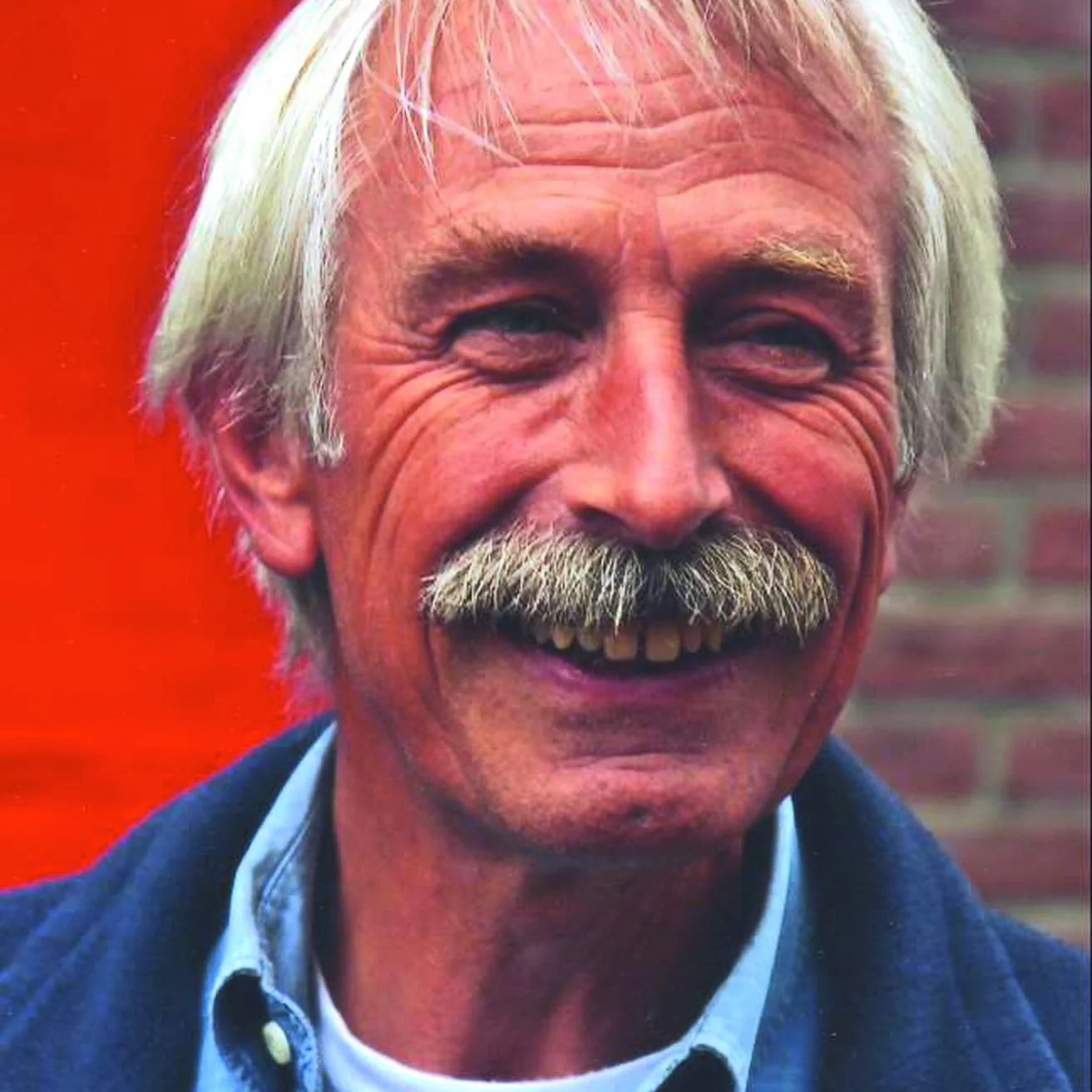
As Huisman’s reputation grew, so did the range of naval architects whose designs brought fresh and exciting challenges to the yard. Over the next ten years or so these names included Jac de Ridder, Groupe Finot, Dick Carter, Gerard Dijkstra, Doug Peterson, Ed Dubois, Einar Ohlson, Laurent Giles, Bob Miller (Ben Lexcen), Volker Bear, Lemstra, Dick Koopmans, Horst Glacer, Germán Frers and Ron Holland.
It is also relevant to note the role of one more designer in this story: E.G. (Riekus) van de Stadt. At the time of the Running Tide project, Huisman had built up a solid business and a growing reputation in building series design aluminium cruiser racers. The Avenir, the Rasbora and the Staron, all designed by Van de Stadt, enabled many new entrants to yachting to acquire and develop seamanship skills and to gain a taste for racing through regattas held on the IJsselmeer and the North Sea. As the yard began to make the transition to building custom race yachts, a number of owners of these series designs began to make their own transition and, in due course, they too placed orders for custom yachts. Among the more notable of these were Willi Illbruck, whose first Pinta in 1969 was of Staron pedigree; Willem Oosterwijk who campaigned his first Staron (originally owned by J. Martens) before building Spirit of Delft; and Hermann Noack, who owned all three series designs – an Avenir, a Rasbora and a Staron in turn – before building his first, fully custom Sabina.
(Research for this article early in 2009 uncovered a current-day brokerage advertisement for a 1968 Rasbora, now forty-one years old. The Dutch owner noted: “This excellent seagoing yacht is in very good condition and always doing well in the regattas.”)
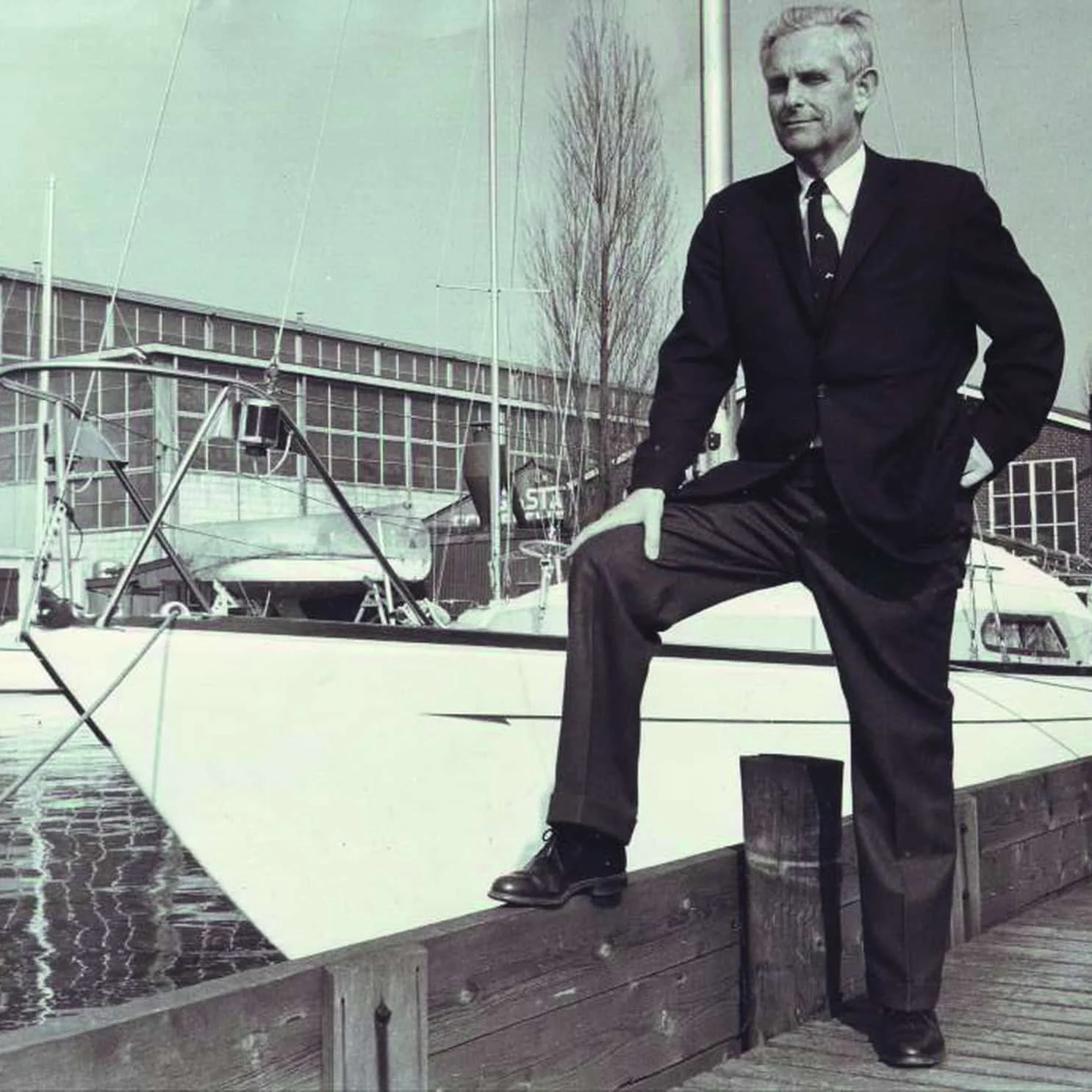
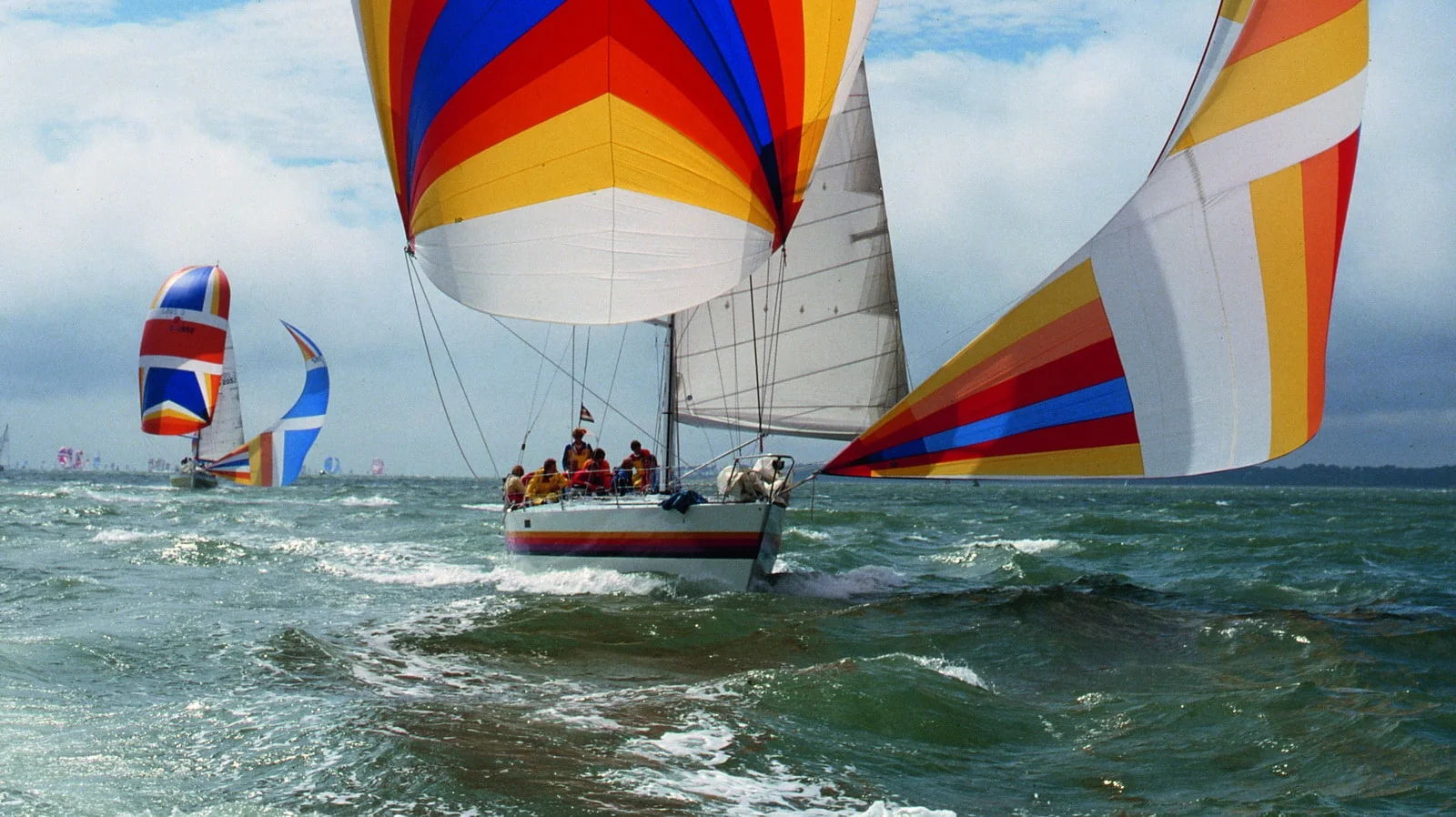
In 1971 Jachtwerf W. Huisman, as the business was then known, completed its move to Vollenhove. As the orders came in steadily, the techniques and infrastructure developed to meet the needs of the owners and their architects. The yard team grew in numbers: by 1972 there were around thirty-fi ve employees. On hearing that rival boatbuilders Frans Maas employed fifty people, Wolter Huisman’s response was: “They’re welcome: if we get to forty people that will be more than enough for me.” In truth, Wolter was never motivated by the ambition of building a big business; he wanted to work on interesting challenges and the number of people required to do so was merely a by-product. Certainly Wolter could never have envisaged that, before he retired, he would have completed construction on the 90 m / 295 ft, three-mast schooner Athena, with an in-house team of more than 400 people on the company payroll. He was, it has to be said, rather inconsistent on this subject. When Alice Huisman wrote in a newsletter that the yard now had in excess of 100 employees, he accused her of being untruthful: “I will never have more than 100 employees,” he rashly claimed.
Wolter always exhibited a restless desire to improve his offering, try new construction techniques and challenge the established order of things. This went down well with owners and architects; as Germán Frers commented, “Wolter was always interested in finding a way to do things better, and he was always ready to hear what you thought he could do better. You just didn’t find this in other yards.” Huisman constantly sought to refi ne the way in which he built the boat itself, but he also turned his attention to winches, spinnaker poles, hatches, and mast and deck fittings. All this activity was driven by more than Huisman’s entrepreneurial spirit or his interest in engineering: it also reflected the unreliability of supply of many components. When you have to deliver the latest Admiral’s Cupper to a no-nonsense owner within a very tight deadline, the last thing you need is to have only one of two primary winches delivered on time. Thus, the development of many deck and rig components was borne as much from the necessity to exercise control over quality and supply as it was from opportunism.
First-hand experience
As a result, a large number of racing yachts, especially in the earlier years, went to sea clothed from top to tail in Rondal masts and hardware. Wolter, who enjoyed racing in those days, used the opportunity when invited to crew, to see for himself how his products stood up to the test of hard racing. Of course, they did not always stand up as well as they might; that was part of the learning process.
But when things went wrong at sea, Wolter took the opportunity to combine his seamanship and engineering skills to produce some kind of a fix to complete the race, no matter what the problem or the weather. His stint in the Navy meant that he took rough seas in his stride, positively relishing the experience. (See Hermann Noack and Sabina, “The Admiral’s Cuppers”, later in this Chapter.)
Wolter’s practical involvement in racing was of great value in optimising the build and the subsequent success of the boats he built. He was able to swap experiences and ideas with the leading owners and designers of the day; great strides towards the realisation of “the next big thing” would often be achieved over a late evening drink with Wolter in his home after the yard had fallen silent.
The culmination of the Huisman yard’s success as a racing yacht builder was certainly the “double crown” of building the two Flyers that successively triumphed in the Whitbread Round the World Race during 1977–1978 and 1981–1982. Of course, there were many other achievements – far too numerous to list in detail in this book – but the following pages highlight some of the people and the yachts that featured prominently in the story of the racing years of the Huisman yard.
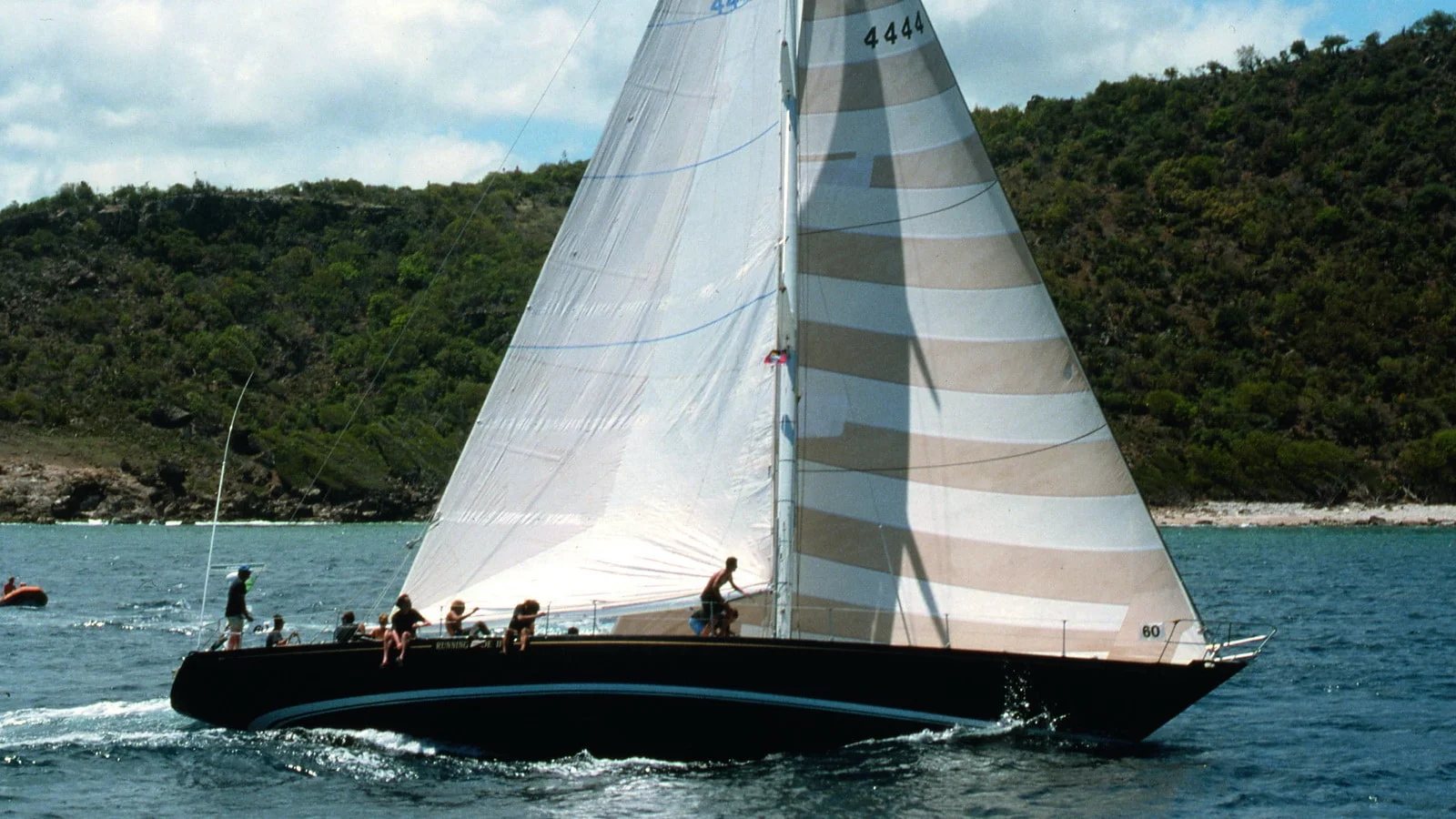
Running Tide
Taking forty years in her ocean stride
Huisman’s first Sparkman & Stephens design – and the first yacht to be built on the Vollenhove site – was the 18.4 m / 60 ft Running Tide. She was launched in 1969, so shares her fortieth birthday with Royal Huisman’s 125th anniversary. Like the yard, she seems to have gone from strength to strength. She still looks as elegant as she did the day she launched and, in common with many Huisman built yachts, appears to have little appetite for retirement. The list of race and regatta wins below says it all.
1970 Bermuda Race Winner
1971 SORC Winner All Classes
1972 Annapolis YC – Fall Series Winner Skip: Ted Turner
1972 SORC 4th All Classes
1973 Miami Palm Beach Winner
1973 STORM Trysail Club Week Winner
1974 Nassau Cup Winner
1976 Bermuda Race Winner All Classes
1977 Old Boat Division Winner Class A
1979 SORC Winner
1980 Bermuda Race Winner
1981 SORC Winner
1982 SORC 2nd Division Class A
1983 Annapolis – Newport Race Winner Class A
1983 Annapolis YC – Viking Trophy Winner
1983 Chesapeake Bay YRA – IOR Winner – six times
RUNNING TIDE WAS NOT RACED BETWEEN 1984 AND 2003
2004 Les Voiles de St. Tropez Route du Jasmin, Jury’s Cup
2005 Les Voiles de St. Tropez Route du Jasmin, Jury’s Cup
2006 Bailli de Suffren Race 2nd in Class
2006 Malta Syracuse 1st in Class
2006 Les Voiles de St. Tropez 3rd in Class
2007 Les Voiles de St. Tropez 4th in Class
2007 Porquerolles 3rd in Class
2007 Les Voiles du Vieux Port – Marseille 2nd in Class
Continue reading about the racing years on this website > inhuis stories & updates:
- Part 2 – The Admiral’s Cuppers [link]
- Part 3 – Herbert von Karajan and Helisara [link]
- Part 4 – The Maxis and the Flyer Campains [link]
This article was first published in the book “Royal Huisman 125 years The Spirit of Individuality”.
